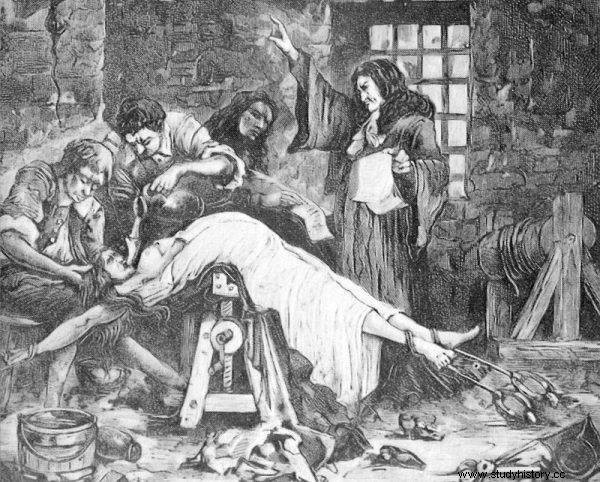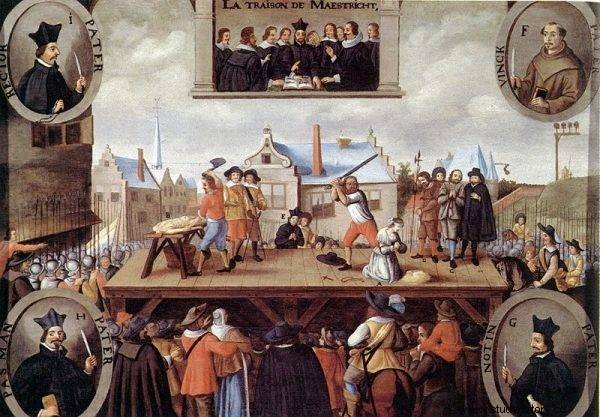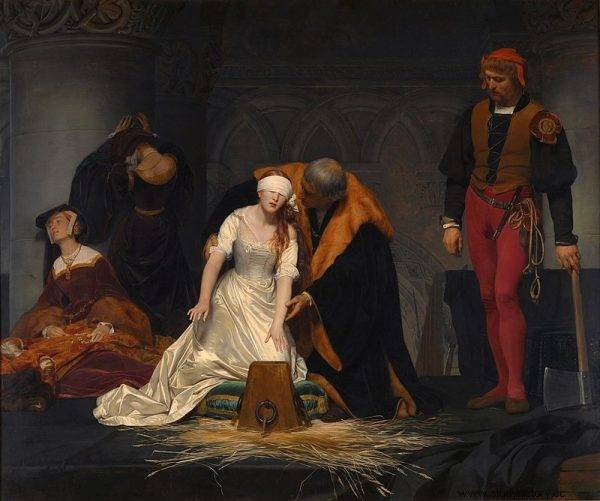Kat didn't have an easy life. The work itself was ungrateful. Added to this was laborious learning and social ostracism. On the other hand, it was possible to earn a lot from the executions.
You close your eyes. Unfortunately, not for long. A loud pounding on the door pulls you out of your half-sleep. You stand up and approach them, passing without a word with your wife, who is just introducing another client to the brothel. There is a job, a master is needed. You will leave the cleanup to the assistant again…
This is probably what your evenings as a executioner would look like. What else could you expect?
Unwanted neighbor
First of all, forget about black. The official costume of the executioner was red, and pieces of red, white and green cloth were often sewn on the sleeves. It is also a myth to cover the face - if executioners wore hoods, then only with an opening for the entire face. They must have seen the condemned man. Failure to comply with the judgment could have cost me my job.
Moreover, the masters of justice were public figures and needed recognition. Is it when accepting orders from the courts and law enforcement services, or when dealing with private interests.

Before the sentence was announced, the executioners questioned the accused. Here, experience and knowledge of anatomy were particularly important. Torture at the beginning of the trial could not cause permanent disability
It cannot be denied, however, that the profession was not one of the most respected. Katowice's apartments were far away from the others. More than once the perpetrators received their own corner in the tower or town tower for free. Worse, they got… a brothel for free. Because they had to drive them, often together with their wives.
If we add to this the obligation to clean public toilet facilities , we get a picture of a man that nobody wanted to shake hands with.
Few people spoke favorably about the executioners. There were even phrases such as "ki kat" or "let the torturers kidnap him". People who worked in this profession were called masters, but small . Their helpers:torturers, rascals, hycls, murderers and torturers. It was a huge insult to address someone outside the industry like that.
Read also:How to torture and then ... heal? Medieval rehabilitation after visiting the torture chamber
Winding career paths
There were several ways to become an executioner. Apprenticeships by a guild member could take up to several years. In Biecz, an executioner guild functioned in Biecz as early as the 14th century, and the 19th century legend even mentions a school The candidate had to be able to read and write, know the anatomy perfectly, as well as torture and execute without hesitation . At the beginning he practiced these on cabbage and dead animals.
While the inexperienced torturer had to repeat the beheading, for a guild student decapitation with one blow was a master exam, after which he received documents confirming his qualifications. In some regions the profession was hereditary. The most influential family of Katowice in Silesia and Lusatia was the Kühn family. The German Neher and Beckels passed down the secrets of the profession from generation to generation for almost 300 years.

While the inexperienced torturer had to repeat the beheading, for a guild student decapitation with one blow was a master's exam
It often happened that the city lacked a master capable of executing. In this case, contracts were signed ... with convicts who were under the death sentence. The new job was the only chance to save a life - it happened that out of a whole group of criminals one chosen one would execute the punishment on other companions.
An inhabitant of Katowice could also start working independently, if anyone decided to hire him. But sometimes the championship stool was taken ... completely by accident.
This is what happened to Antoni Strzelbicki from Lviv, who killed his opponent in a duel. The watching people began to call him the executioner. Surprisingly, the man actually went to study in Krakow, allegedly through a pseudonym that stuck to him. After the death of Franciszek, who trained him, he became the Krakow champion.
Read also:Like Piekarski's torments - that's how assassins were punished in 17th-century Poland
The Executioner's Responsibilities
What exactly was the scope of the enforcers' duties? Of course, the execution of the death penalty - in Europe, until the guillotine was invented, most often it was hanging, beheaded with an ax or a sword (depending on the origin and type of crime).
Before the sentence was announced, the executioners questioned the accused. Experience and knowledge of anatomy were particularly important here. Torture at the beginning of the trial could not cause permanent disability, and in its later stages - kill the convict before the official execution .

What exactly was the scope of the enforcers' duties? Of course, the execution of the death penalty - in Europe, until the guillotine was invented, most often it was hanging, beheaded with an ax or a sword
The second pillar of this profession was the already mentioned running of brothels and taking care of their employees, as well as flogging women who were engaged in prostitution on their own .
On the other hand, the least known duty of executioners today is ... cleaning work. These included catching wild animals and collecting those already dead from the streets, cleaning the moat, cleaning the market square several times a year, and in addition - the collection of mud and manure from the city. More than once, when medics were lacking, the executioners treated wounds and treated various injuries, as they were best acquainted with the structure of the human body.
Read also:Burning and breaking joints - torture in modern times
Was it worth it?
Certainly the executioners did not slap the proverbial poverty - they signed contracts with the city, on the basis of which they most often received a weekly salary, and besides, bonuses for executed executions. Brothels were another source of profit.
Masters were guaranteed bodily inviolability - even a noble for wounding or killing an executioner could be beheaded. And when the wages in a given city turned out to be too low, there were additional orders or sales of the office. Between 1567 and 1612, Katowice changed hands six times in this way.
On the other hand, the enforcers were doomed to social ostracism. In the countries of Western Europe, they still had a chance for promotion and privileges. Some German states allowed for the nobility to be awarded to an executioner who carried out a certain number of executions. Parisian masters collected tolls on goods in the market hall, received materials for new clothes, and at Saint-Germain Abbey they walked at the front of the procession on St. Vincent.
In Poland it was out of the question. The torturers were treated as unclean - they avoided looking at them and sitting at one table . Everything the executioner touched was treated as dirty. Bakers turned the loaves of bread intended for them upside down so that they would not choose the bread themselves. Even a separate, seemingly privileged box in the church was in fact a way of isolating from the environment.
The people who handled the sentences were themselves doomed to a great deal of loneliness.
Sources:
- Czajka A., Fantasy or reality? Medieval executioner costume in the imagination of Jan Matejko , Łódź 2016.
- Pacholec M. M., Kat as a member of the municipal community in the Polish-Lithuanian Commonwealth of the 16th-18th centuries , Olsztyn 2009.
- Rosa W., On the side of criminals or law enforcement services, i.e. the place of the executioner in the justice system in former Poland [in:] Studies in the History of the State and Polish Law. Volume 19 , Krakow 2016.
